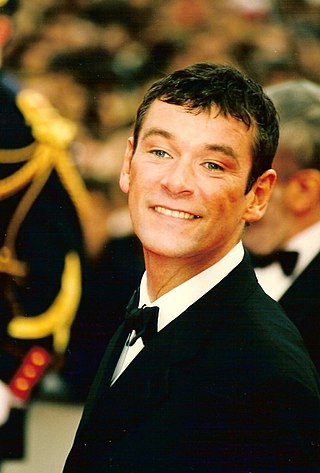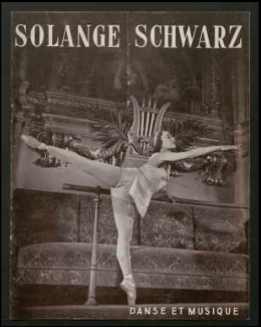Related Research Articles

The Paris Opera Ballet is a French ballet company that is an integral part of the Paris Opera. It is the oldest national ballet company, and many European and international ballet companies can trace their origins to it. It is still regarded as one of the four most prominent ballet companies in the world, together with the Bolshoi Ballet in Moscow, the Mariinsky Ballet in Saint Petersburg and the Royal Ballet in London.
Aurélie Dupont is a French ballet dancer who performed with the Paris Opera Ballet as an Étoile.
Attilio Labis was a French ballet dancer and teacher. He was regarded as a star of the Paris Opera.
Mathieu Ganio is a French danseur étoile of the Paris Opera Ballet.
Stéphane Bullion is a retired French Étoile dancer of the Paris Opera Ballet.

Laetitia Pujol is a French ballet dancer. She joined the Paris Opera Ballet in 1993, becoming a principal in 2000 and a star (étoile) in 2002.

Patrick Dupond was a French ballet dancer and artistic director.
José Carlos Martínez is a Spanish dancer and choreographer. He was a danseur étoile of the Paris Opera Ballet and artistic director of the Spanish National Dance Company. He became the director of dance at Paris Opera Ballet in December 2022.

Lycette Darsonval was a French ballet dancer.

Wilfride Piollet was a French ballerina and choreographer. She was born in Saint-Rambert-d'Albon. Her philosophy of dance and her research led to the publication of several books. Piollet joined the Paris Opera Ballet company in 1960. She gained the rank "coryphée" in 1963, "sujet" in 1964, soloist in 1966, and was promoted to principal dancer (étoile) in 1969. In 1973, Nouvelle lune c-à-d was created for her retirement of the Paris Opera. Invited as a guest by Rudolf Nureyev, she danced at the Paris Opera until 1990, the year when Jean Guizerix left. At the Paris Opera and worldwide, she performed the classical, neo-classical and contemporary repertory, and from the 1980s, the Baroque and Renaissance ones. She ended her dance career in 2003 with a piece on Isadora Duncan's dances studied with Madeleine Lytton, and performed with Jean Guizerix.
Isabelle Ciaravola is a French ballet dancer. From 1990, she danced with the Paris Opera Ballet where she rose to the top rank of étoile in 2009. Since retiring from the stage in February 2014, she has devoted most of her time to teaching.

Alice Renavand is a French ballet dancer. After joining the Paris Opera Ballet in 1997, she became a principal in 2012 and a star in December 2013. Shortly afterwards, she was described as having "la beauté du diable" as Lizzie in Fall River Legend.
Myriam Ould-Braham is a French ballet dancer. After joining the Paris Opera Ballet in 1999, she became a première danseuse (principal) in 2005 and was elevated to the rank of étoile (star) in 2012.
Josua Hoffalt is a French ballet dancer who was a Danseur Étoile at the Paris Opera Ballet from 2012 to 2018.
Guillaume Diop is a French ballet dancer. He joined the Paris Opera Ballet in 2018, and was promoted to étoile in March 2023, becoming the first mixed black person to reach a principal rank in the company's history.

Jacqueline Moreau (1926–2018) was a French ballerina and ballet teacher. From the age of nine, she attended the Paris Opera Ballet School, training under Carlotta Zambelli. She performed with the Paris Opera Ballet from 1942, soon gaining the rank of première danseuse but left in 1951 when she realized she would not be ranked a danseuse étoile. From 1953 to 1959, she was a star performer at the International Ballet of the Marquis de Cuevas based in Monte-Carlo. For the remainder of her career, she taught first at the Paris Opera Ballet School and then at the Boulogne-Billancourt Conservatory until her retirement in 1990.

Solange Schwarz (1910–2000) was a French ballerina who trained at the Paris Opera Ballet School. After gaining the rank of danseuse étoile at the Opéra-Comique in 1932, she was the first female dancer to earn the official étoile distinction at the Paris Opera in 1940 for performing the leading role in Serge Lifar's premiere of Entre deux rondes. From 1945, she performed with the Ballets des Champs-Élysées and with the companies created by the Marquis de Cuevas. After retiring from the stage in 1957, she taught dance for over 20 years at the Conservatoire de Paris.
Claire Motte (1937–1986) was a French ballerina, choreographer and dance teacher. After studying under Carlotta Zambelli at the company's school, she entered the Paris Opera Ballet when she was 14. Rising quickly through the ranks, she was named a danseuse étoile in December 1960. As a result of her outstanding technique, leading choreographers including George Balanchine and Serge Lifar sought to include her in their ballets. She was frequently a partner of Jean-Pierre Bonnefoux. In parallel, Motte taught dance and in 1977 was appointed professor at the Paris Opera and at the Conservatoire de Paris. Four years after she had left the stage, in 1983 Rudolf Nureyev appointed her ballet master for Swan Lake.

Marion Barbeau is a French ballerina and actress.
Éric Binh Vu-An was a French dancer, choreographer, and actor.
References
- 1 2 "Le chemin des étoiles, 1940–1972". Google Cultural Institute. Archived from the original on April 1, 2014.
- ↑ La Danse, film by Frederick Wiseman, 2009, 159 min.
- 1 2 3 "Le chemin des étoiles, 1972–2014". Google Cultural Institute. Retrieved 3 November 2014.
- ↑ "Retraite des danseurs de l'Opera National de Paris".
- ↑ "La danseuse étoile Aurélie Dupont fait ses adieux à la scène". Vanity Fair. 19 May 2015. Retrieved 3 June 2015.
- ↑ Boisseau, Rosita (26 September 2017). "Danse: les adieux d'une étoile sur une rivière de joyaux". Le Monde. Retrieved 26 September 2017.
- ↑ Atanasio, Sofia (2 April 2018). "Marie-Agnès Gillot a fait ses adieux sur la scène de l'Opéra de Paris". France Musique. Retrieved 3 April 2018.
- ↑ Jouve, Sophie (18 February 2016). "Benjamin Pech, des adieux à la scène de l'Opéra en forme d'au revoir". Culturebox. Retrieved 21 February 2016.
- ↑ Sulcas, Roslyn (2023-09-22). "At Paris Opera Ballet's Gala: Champagne, Chanel, Contemporary Dance". The New York Times. ISSN 0362-4331 . Retrieved 2023-09-25.
- ↑ Renard, Bertrand (14 May 2017). "A Garnier, les adieux en solo de Jérémie Bélingard sous une pluie de confettis". Culturebox. Retrieved 15 May 2017.
- ↑ Bavelier, Ariane (30 December 2018). "Karl Paquette, un grand pas vers l'avenir". Le Figaro. Retrieved 3 January 2019.
- ↑ "Opéra, les adieux de Stéphane Bullion". France Culture (in French). 2022-05-30. Retrieved 2023-09-25.
- ↑ Bertrand, Amélie. "Adieux à la scène de Josua Hoffalt". Danses avec la plume. Retrieved 3 January 2019.
- ↑ Boisseau, Rosita (2024-05-16). "Myriam Ould-Braham tire sa révérence à l'Opéra de Paris". Le Monde (in French). Retrieved 2024-05-21.
- ↑ Lopez, Louis-Valentin (2022-07-14). "Adieux reportés pour l'étoile Alice Renavand, blessée sur la scène de Garnier". France Musique (in French). Retrieved 2023-09-25.
- ↑ "Laura Hecquet : "Première étoile nommée par Millepied, ça me touche encore plus"". Culturebox. Retrieved 24 March 2015.
- ↑ "Étoile dancer Laura Hecquet will bid farewell to the stage on Thursday 10 October 2024". Opéra national de Paris. Retrieved 2024-10-16.
- ↑ Boisseau, Rosita (29 December 2016). "Germain Louvet élevé au rang de danseur étoile". Le Monde. Retrieved 29 December 2016.
- ↑ "Léonore Baulac nommée danseuse étoile de l'Opéra de Paris". Le Monde. 1 January 2017. Retrieved 1 January 2017.
- ↑ Boisseau, Rosita (3 March 2017). "Hugo Marchand nommé danseur étoile à Tokyo". Le Monde. Retrieved 3 March 2017.
- ↑ "Valentine Colasante nommée Danseuse Étoile de l'Opéra national de Paris". Opéra national de Paris. Retrieved 5 January 2018.
- ↑ Park, Jae-eun (11 June 2021). "Korean ballet dancer Park Sae-eun named "star" dancer at the Paris Opera Ballet". Korea Herald.
- ↑ "François Alu, virtuose et rebelle de l'Opéra, nommé danseur étoile". France 24. AFP. 24 April 2022. Retrieved 25 April 2022.
- ↑ Boisseau, Rosita (2022-11-24). "Le danseur François Alu préfère « laisser la place d'étoile à quelqu'un qui occupera le poste à plein temps »". Le Monde (in French). Retrieved 2024-05-23.
- 1 2 "Paris Opera Ballet names New Zealand dancer among two new stars". France24. 3 March 2023.
- ↑ "Guillaume Diop devient le premier danseur étoile noir de l'Opéra de Paris". Huffpost. 11 March 2023.
- ↑ Boisseau, Rosita (2024-03-28). "Bleuenn Battistoni nouvelle danseuse étoile de l'Opéra national de Paris". Le Monde (in French). Retrieved 2024-05-22.
- ↑ Boisseau, Rosita (2024-12-31). "Roxane Stojanov, new étoile of the Paris Opera ballet". Le Monde . Retrieved 2025-01-02.